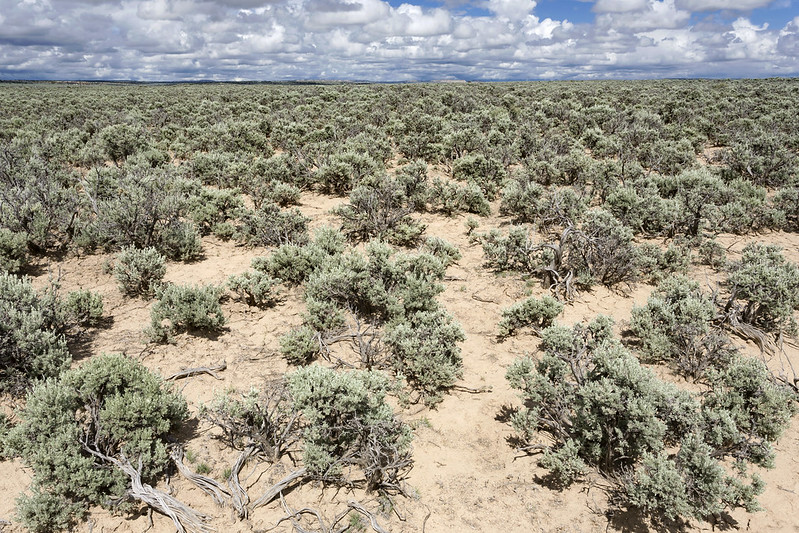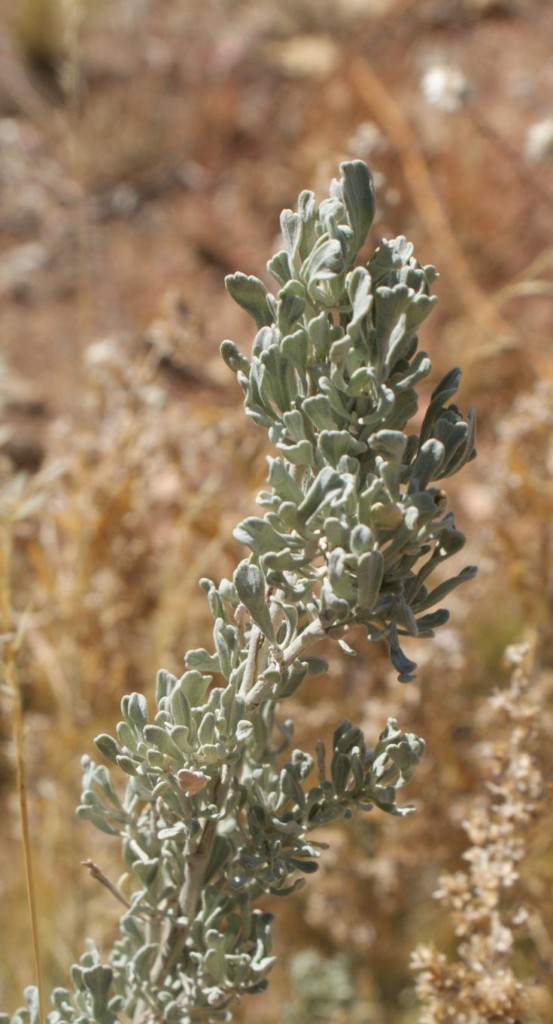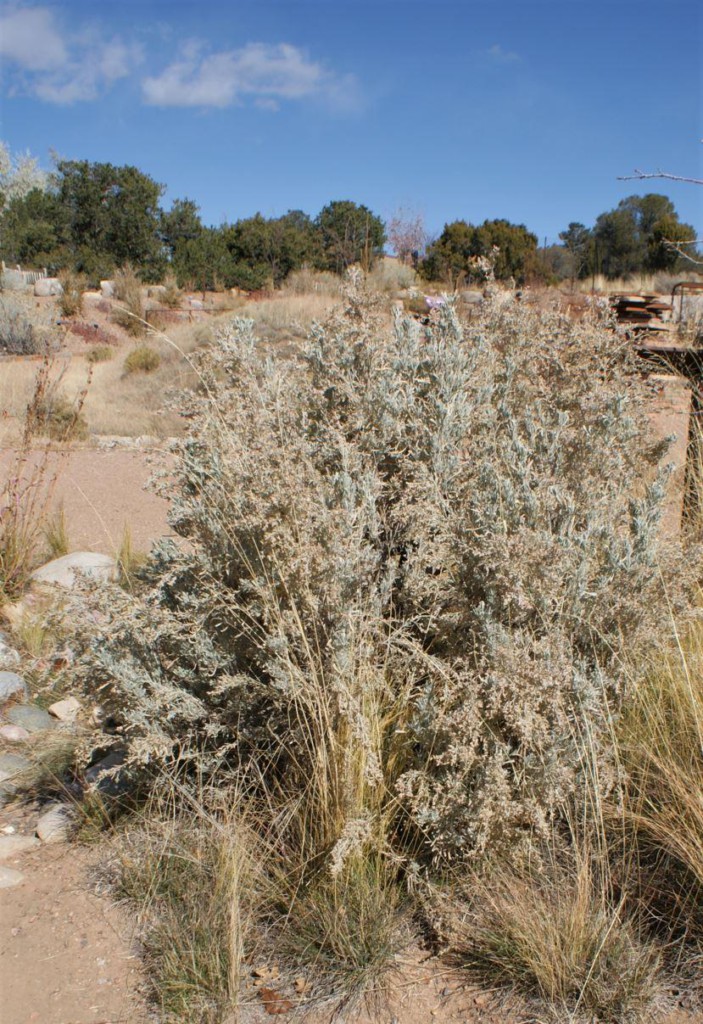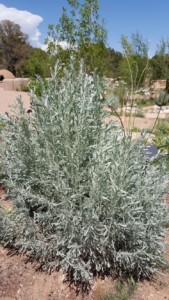Scientific name: Artemisia tridentata Nutt.
Common Name: big sagebrush, Great Basin sagebrush
Family: Asteraceae (Aster Family)
Article by Susan Bruneni
The vast landscape of the American West is often portrayed in art forms with seas of big sagebrush. Artemsia tridentata has a native range that spans from the southern Rocky Mountains of New Mexico to coastal ranges of Baja California (Mexico), to the northern Rockies of Canada. The plant has come to symbolize the many wonders of the American West.

Big sagebrush landscape northwest of Pot Mesa, between Arroyo Pueblo Alto and Cañada Corrales, New Mexico, 24 May 2015. Photo credit: Patrick Alexander.

Artmesia tridentata leaves. Photo by Norman Marks.
The growth habit of the big sagebrush is an evergreen shrub, 1 1/2 to 9 feet tall, with a short trunk and branches from the base twisting and gnarled, growing as wide as 15 feet. The shape of the leaves give the plant its species name, “tridentata” from their small, wedged-shaped, and toothed end which usually has 3 lobes. They have a velvety surface and range in color between silvery and bluish-gray. The plant is strongly aromatic, described as sweet or pungent, especially after a rain. It produces elongated, loose clusters of small yellow flowers in late summer.
Big sagebrush is the dominant shrub over vast areas of the Great Basin region. Several very similar subspecies have been identified, adapting to soil types and the amount of water the soil provides. Wildlife such as deer, moose, elk, antelope, and bighorn sheep, forage on this valuable plant especially in late winter and spring. Sage grouse (Centrocercus urophasianus) are one of the few animal species that almost entirely rely on the foliage as a food source. The shrub also provides nesting sites for a variety of songbirds. More nutritious than alfalfa, this shrub is 16% proteins, 15% fats, and 47% carbohydrates.

Sagebrush late fall. Photo by Norman Marks.
The US Forest Service conducts routine surveys of piñon-juniper woodlands in the west. Big sagebrush commonly grows within these areas to take advantage of thicker soil. It completes a unique ecosystem. The larger trees provide protection for wildlife from weather and predators, while the understory sagebrush offers nutrition and additional protection. The West Forest Inventory program tracks the mule deer transition from high mountain areas to lower elevations as cooler weather approaches. The piñon-juniper-sagebrush habitats provide a transition rest-stop for the hungry deer with ample food and shelter.
In order to survive the harsh climate where the big sagebrush grows, it has adaptations to protect it from the heat, wind, and lack of moisture. The tiny hairs that cover the leaves and give it the velvety appearance help keep moisture in and prevent drying from heat and wind. During extremely low precipitation and drought, the plant can drop it leaves and minimize water loss. The root system also works by utilizing the tap root to pull water from deep soils to shallow roots during the night which allows survival throughout the rest of the day.
It is common in the northern half of New Mexico, where it grows in deep soils in bottoms and drainages, in piñon-juniper woodlands, and on slopes of mixed conifer forests. It will grow in dry, rocky soils and limestone soils. Well-drained soils are essential to prevent root rot. These nitrogen-fixing plants are very drought tolerant. Periodic pruning to remove old stems rejuvenates the plant. Big sagebrush spreads easily from seed, but requires the presence of mycorrhizal fungi. Fires can kill the plant; and re-colonization is impeded when the soil fungi are killed by severe fires. Sagebrush ecosystems invaded by cheatgrass, which promotes fires, have been dramatically altered.

Sagebrush growing in the Botanical Garden. Photo credit: Joy Mandelbaum.
Native Americans use big sagebrush leaves for medicinal and ceremonial purposes. Settlers found it useful to spread in the pantry to ward off insects and rodents. It makes excellent firewood. The volatile oils are so flammable that they can even cause green plants to burn. A yellow-to-gold dye is obtained from the leaves, buds, and stems combined. The fibrous bark is used for weaving mats, baskets and cloth.
Big sagebrush is growing at the Botanical Garden in the ethnobotanical areas of Ojos y Manos: Eyes and Hands, learn more and see its location on our Garden Explorer.
Sources consulted and/or cited:
“Artemisia tridentata” . National Park Service. 24 Feb 2015. Web. 31 Oct 2019. Retrieved from: https://www.nps.gov/arch/learn/nature/asteraceae_artemisia_tridentata.htm
“Artemisia tridentata”. Native Plant Information Network. Lady Bird Johnson Wildflower Center. Web. 19 Feb 2009. Web. 31 Oct. 2019. Retrieved from: https://www.wildflower.org/plants/result.php?id_plant=artr2
“Artemisia tridentata”. Garden Explorer. Santa Fe Botanical Garden. Web. 31 Oct 2019. Retrieved from: https://santafebotanicalgarden.gardenexplorer.org/taxon-751.aspx
“Big sagebrush”. The Great Basin and Invasive Weeds. Web. 31 Oct 2019. Retrieved from: https://www.usu.edu/weeds/plant_species/nativespecies/nativespecies.html.
Rowland, M.M., 2019, The effects of management practices on grassland birds—Greater Sage-Grouse (Centrocercus urophasianus), chap. B of Johnson, D.H., Igl, L.D., Shaffer, J.A., and DeLong, J.P., eds., The effects of management practices on grassland birds: U.S. Geological Survey Professional Paper 1842, 50 p., https://doi.org/10.3133/pp1842B.


